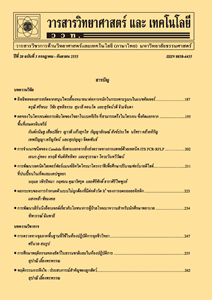การทดลองขวดสีน้ำเงิน
Main Article Content
Abstract
บทคัดย่อ
การทดลองขวดสีน้ำเงินได้รับการกล่าวถึงเป็นครั้งแรกในบทความด้านเคมีศึกษา โดยใช้เป็นการทดลองอย่างง่ายสำหรับอธิบายจลนศาสตร์เคมี สูตรดั้งเดิมประกอบไปด้วยน้ำตาลกลูโคส โซดาไฟ และเมทิลีนบลูปริมาณเล็กน้อย สารละลายจะเปลี่ยนเป็นสีน้ำเงินเมื่อเขย่าขวด และค่อย ๆ จางลงจนกระทั่งไม่มีสีเมื่อตั้งทิ้งไว้ กระบวนการเกิดสีและจางไปของสีน้ำเงินสามารถเกิดขึ้นซ้ำได้หลายครั้ง ซึ่งเปรียบเทียบได้กับสีของเลือดสัตว์ในกระบวนการหายใจ มีการประยุกต์ใช้การทดลองนี้เพื่อการสอนอย่างหลากหลาย ไม่เพียงเพื่ออธิบายเคมีเชิงฟิสิกส์ แต่ยังใช้ในทางเคมีเชิงชีววิทยาและเคมีอินทรีย์ แม้ว่าแนวคิดของการทดลองนี้จะไม่ซับซ้อน แต่ก็มีการพัฒนาต่อยอดอีก ประกอบไปด้วย การประยุกต์จากสูตรดั้งเดิม (เช่น การทดลองไฟจราจรเคมี การทดลองวาเลนไทน์ การเปลี่ยนน้ำตาลและตัวทำละลาย การใช้กรดแอสคอร์บิกแทนโซดาไฟและน้ำตาลตามแนวคิดเคมีสะอาด การศึกษาลวดลายสารเคมีในระบบเมทิลีนบลู-กลูโคส) และการประยุกต์ใช้งานปฏิกิริยา (เช่น ชุดตรวจออกซิเจนสำหรับอาหารในบรรจุภัณฑ์ และตัวกำจัดออกซิเจนสำหรับสร้างภาพความละเอียดสูง) ในบทความนี้เราสรุปงานที่เกี่ยวข้องกับการทดลองขวดสีน้ำเงินตั้งแต่ ค.ศ. 1954 รวมถึงเสนอช่องว่างและทิศทางของการวิจัยในอนาคต
คำสำคัญ : การทดลองขวดสีน้ำเงิน; เคมีเชิงชีววิทยา; จลนศาสตร์เคมี; การเกิดลวดลายทางเคมี; เคมีศึกษา
Abstract
The blue bottle experiment was first mentioned in the chemical education literature as a simple experiment on kinetics. The original formulation contains only glucose, caustic soda and small amount of methylene blue. The solution turns blue when shaken and fades to colourless after standing. This bluing/de-bluing process can be repeated many times and can be compared to the colour of animal blood in the respiratory cycle. The pedagogical application of this classical demonstration is versatile, not only in physical chemistry but also in biological and organic chemistry. Though the concept of this experiment is relatively straightforward, there is growing body of research on it. These include a number of modifications to the original formulation (e.g. chemical traffic light, vanishing valentine, variations of sugar and solvent, replacement of NaOH and sugar with ascorbic acid for green chemistry), chemical pattern formation in methylene blue-glucose system and a number of applications of the reaction (e.g. oxygen indicator for intelligent food packaging and oxygen scavenger for super-resolution imaging). In this paper, we present a comprehensive review of all literatures relating to the experiment since 1954 and discuss the gaps and directions for future research.
Keywords: blue bottle experiment, biological chemistry, chemical kinetics, chemical pattern formation, chemical education

